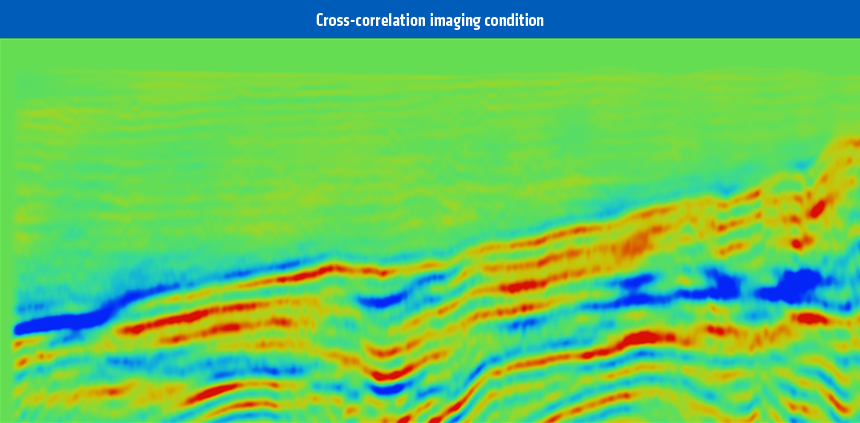- Uses diving waves, refractions and reflections together to reduce dependence upon very long offsets and provide high-fidelity velocity models
- Avoids cycle-skipping artifacts and delivers models with correct long wavelength information
- Removes migration isochron artifacts resulting in accurate deep velocity models
- High-resolution deep velocity updates translate to improved subsurface images and robust reservoir characterization
The figure below has the technical name of the 'sensitivity kernel' for FWI. Written formally, it shows the sensitivity of the FWI misfit function to the perturbation of a specific parameter, in this case, the velocity is derived from field shot gathers. In simpler terms, it shows where the velocity model is updated for a particular source-receiver offset (5 km here) using two types of FWI solution: 'Transmission FWI' which uses diving waves and refractions to provide velocity model updates, and 'Reflection FWI' which uses reflections to provide velocity model updates.
Sensitivity kernels for both transmission FWI and reflection FWI that use the conventional crosscorrelation imaging condition (left) and the inverse scattering imaging condition (right). The new PGS FWI kernel (right) removes migration isochron artifacts resulting in accurate deep velocity models.
This figure's left and right versions appear similar but are not. First, let us examine what is different between transmission FWI and reflection FWI. Heuristically, it is obvious why transmission FWI requires extremely long offsets to provide reasonably deep velocity updates: The 'banana' transmission FWI kernel only affects the velocity model in this example for quite shallow depths. Velocity updates at larger depths will require much longer offsets. In contrast, reflection FWI clearly provides much deeper velocity updates for the same offset.
Unfortunately, FWI has historically been more challenging for most people to implement. One challenge has been the high wavenumber 'migration isochron' that dominates the left-side sensitivity kernel based upon the conventional crosscorrelation imaging condition. In contrast, the right-side sensitivity kernel uses a new Inverse Scattering Imaging Condition (ISIC) developed by PGS and is free of this artifact. For more details refer to the paper by Ramos-Martinez et al. presented at the 2016 SEG conference.
The figure below compares the results of a velocity model derived using the historical implementation of reflection FWI using the crosscorrelation imaging condition (upper) versus the new implementation of reflection FWI using the new PGS imaging condition (lower). The difference is remarkable. Whilst it is inviting to view the upper result as containing spectacular resolution, and thereby 'fit for direct interpretation' in the manner wherein reflectivity seismic images are interpreted, nothing could be further from the truth. Most of the high wavenumber detail in the upper velocity-model update is false: Artifacts of the migration isochron problem in the left-side FWI sensitivity kernel above. The lower velocity model update is the correct representation of the geology in this location.

FWI velocity model updates derived using the conventional crosscorrelation imaging condition (upper) and the inverse scattering imaging condition (lower). Most of the high-wavenumber detail in the upper velocity-model update is false due to artifacts of the migration isochron. The lower velocity model update is generated using the new PGS FWI kernel is the correct representation of the geology.
Another well-known challenge to FWI is cycle skipping which also contributes to high wavenumber velocity model artifacts such as those in the upper part of the figure above. In addition to the better imaging condition, PGS is also making progress with sophisticated regularization schemes used to elegantly avoid cycle skipping during FWI.
It is also worth noting that reflection FWI does not only contribute high-resolution, deep velocity model updates. Some areas such as those affected by seafloor rugosity or very shallow geological heterogeneities may derive more benefit to shallow velocity model building using reflections rather than diving waves and refractions.
Contact a PGS expert
If you have a question related to our Imaging & Characterization services or would like to request a quotation, please get in touch.